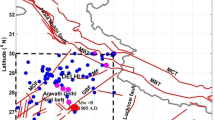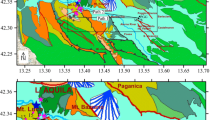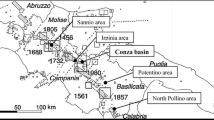Abstract
Delhi, the capital of India, is prone to severe seismic hazards, not only from local events but also from Himalayan earthquakes at distances of 250–300 km. Standard techniques are not sufficiently reliable to completely characterize the seismic hazards in this case due to the difficulty of predicting the occurrence of earthquakes (frequency–magnitude relations) and of properly treating the propagation of their effects (attenuation laws), especially their long-period components. In order to give a sound description of the seismic ground motion due to an earthquake in such a given range of distances (and magnitudes), we use modelling techniques developed from physics of the seismic source generation and propagation processes. Such models take into account the directivity effect of rupture propagation and the attenuation of (long-period) ground motions. The generated ground motion scenarios permit us to build a very important knowledge base to be fruitfully used by civil engineers, since long period ground motions, especially if amplified by deep sedimentary basins, can represent a severe threat for large scale structures (e.g. lifelines and bridges) and tall buildings, which are widespread in fast-growing megacities. In this study, we simulate the ground motion, at bedrock level, in Delhi city, for an earthquake scenario corresponding to a source of Mw = 8.0 located in the central seismic gap of Himalayas, at an epicentral distance of about 300 km from Delhi city. By means of several parametric studies, we simulate the time histories using Size Scaled Point Source, Space and Time Scaled Point Source and Extended Source models. Together with the complete time histories (displacements, velocities and accelerations, from which the peak amplitudes have been extracted), we have also used the displacement response spectrum to characterize the seismic input at Delhi. Not only is the displacement response spectrum of great significance to modern displacement-based design engineering approaches, but it is probably the best parameter by which to characterize the destructiveness potential of earthquakes located at such great distances from the target sites (of the order of 300 km), since the energy of the seismic input is mainly concentrated at long periods (in general, greater than 1 s) and it cannot be determined by straightforward integration of velocity or acceleration response spectra.












Similar content being viewed by others
References
Aki, K., Strong motion seismology, In Strong Ground Motion Seismology (ed. M. Erdik and M. Toksöz) (NATO ASI Series, Series C: Mathematical and Physical Sciences, D. Reidel Publishing Company, Dordrecht, Vol. 204, 1987) pp. 3–39.
Decanini, L., Mollaioli, F., and Oliveto, G., Observations and lessons learned from the earthquake of 13th December 1990 in South-East Sicily, In Proc. of the 10th European Conference on Earthquake Engineering (ed. Duma) (Balkema, Wien, 1994) pp. 1935–1943.
Decanini, L., and Mollaioli, F. (1998), Formulation of elastic earthquake input energy spectra, Earthq Eng Struct Dyn 27, 1503–1522.
Fäh, D., Suhadolc, P., and Panza, G. F. (1993a), Variability of seismic ground motion in complex media: the Friuli area (Italy). In Geophysical Exploration in Areas of Complex Geology II (eds. Cassinis, R., Helbig, K. e Panza, G. F.), J Appl Geophys 30, 131–148.
Fäh, D., Iodice, C., Suadolc, P., and Panza, G. F. (1993b), A new method for the realistic estimation of seismic ground motion in megacities: the case of Rome. Earthq Spectra 9, 643–668.
Florsch, N., Fäh, D., Suhadolc, P., and Panza, G. F. (1991), Complete synthetic seismograms for high-frequency multimode SH-waves, PAGEOPH, 136, 529–560.
G.S.I., Contribution of Geological Survey of India in Delhi Area—A resume (1997) 1–41.
Gusev, A. A. (1983), Descriptive statistical model of earthquake source radiation and its application to an estimation of short period strong motion, Geophys J R Astronom Soc 74, 787–800.
Gusev (2010), Broadband kinematic stochastic simulation of an earthquake source: a refined procedure for application in seismic hazard studies, Pure Appl Geophys (this issue).
Gusev, A. A., and Pavlov, V. (2006), Wideband simulation of earthquake ground motion by a spectrum-matching, multiple-pulse technique. First European Conference on Earthquake Engineering and Seismology (a joint event of the 13th ECEE & 30th General Assembly of the ESC). Geneva, Switzerland, 3–8 September 2006. Paper Number: 408.
Haskell, N. (1964), Total energy and energy spectral density of elastic wave radiation from propagating faults, Bull Seismol Soc Am 54, 1811–1842.
Housner, G. W., Limit design of structures to resist earthquakes, In Proc. of the 1st World Conference on Earthquake Engineering (Berkeley, California, 1956), pp. 5.1–5.13.
Housner, G. W., Spectrum Intensities of Strong Motion Earthquakes, In Proc. Symposium of Earthquake and Blast Effects on Structures, (EERI, Los Angeles, California, 1952) pp. 21–36.
Houston, H., and Kanamori, H. (1986), Source spectra of great earthquakes: teleseismic constraints on rupture process and strong motion, Bull Seismol Soc Am 76, 19–42.
Iyengar, R. N. (2000), Seismic status of Delhi Megacity, Curr Sci 78(5), 568–574.
Iyengar, R. N., and Ghosh, S. (2004), Microzonation of earthquake hazard in greater Delhi area, Curr Sci 87(9), 1193–1202.
Joshi, K. C., Sharda, Y. P., Singh, J., and Gupta S. K. (2006), Seismic microzonation of Delhi urban complex, Geological Survey of India special publication number 87.
Joyner, W. (1984), A scaling law for the spectra of large earthquakes, Bull Seismol Soc Am 74, 1167–1188.
Kenneth, C. E., and Scott, A., Characterization of large velocity pulses for laboratory testing, (PEER-2002/22, Pacific Earthquake Engineering Research Center, University of California, Berkeley, 2002-04, 400/P33/2002-22).
Mukhopadhyay, S., Pandey, Y., Dharmaraju, R., Chauhan, P. K. S., Singh, P., and Dev, A. (2002), Seismic microzonation of Delhi for ground-shaking site effects, Curr Sci 82(7), 877–881.
Nunziata C. (2005), FTAN method for detailed shallow VS profiles, Geologia Tecnica e Ambientale. 3, 51–69.
Panza, G. F. (1985), Synthetic seismograms: the Rayleigh waves modal summation, J Geophys 58, 125–145.
Romanelli F., Bekkevold J., and Panza, G. F. (1997), Analytical computation of coupling coefficients in non-poissonian media, Geophys J Int 129, 205–208.
Panza, G. F., Suhadolc, P. (1987), Complete strong motion synthetics, In: Seismic Strong Motion Synthetics, Computational Techniques 4 (ed. B. A. Bolt) (Academic Press, Orlando, 1987), pp. 153–204.
Panza, G. F., Romanelli, F., and Vaccari, F. (2001), Seismic wave propagation in laterally heterogeneous anelastic media: theory and applications to the seismic zonation, Adv Geophys (Academic press). 43, 1–95.
Parvez, I. A., Vaccari, F., and Panza G. F. (2006), Influence of source distance on site effects in Delhi city, Curr Sci 91(6), 827–835.
Parvez, I. A., Panza, G. F., Gusev, A. A., and Vaccari, F. (2002), Strong-motion amplitudes in Hiamalayas and a pilot study for the deterministic first-order microzonation in a part of Delhi city, Curr Sci 82, 158–166.
Parvez, I. A., Vaccari, F., and Panza, G. F. (2003), A deterministic seismic hazard map of India and adjacent areas, Geophys J Int 155, 489–508.
Parvez, I. A., Vaccari, F., and Panza, G. F. (2004), Site-specific microzonation study in Delhi metropolitan city by 2-D modelling of SH and P-SV waves, Pure Appl Geophys 161, 1165–1184.
Paskaleva, I., Dimova, S., Panza, G. F., and Vaccari, F. (2007), An Earthquake scenario for the microzonation of Sofia and the vulnerability of structures designed by use of the Eurocodes, Soil Dyn Earthq Eng 27, 1028–1041.
PEER, PEER 2001/09 Report: Ground Motion Evaluation Procedures for Performance-Based Design (eds. J. Stewart, S. Chiou, J. Bray, R. Graves, P. Somerville, N. Abrahamson) (2001).
Rao K. S., and Satyam N (2005) Assessment of shear wave velocity in Delhi using MASW method, Proceedings Indian Geotechnical Conference 2005, Ahmedabad 149–152.
Reiter, L. Earthquake Hazard Analysis: Issues and Insights (Columbia University Press 1990).
Romanelli, F., Bing, Z., Vaccari, F., and Panza, G. F. (1996), Analytical computation of reflection and transmission coupling coefficients for Love waves, Geophys J Int 125, 132–138.
Sharma, M. L., Narayan, J. P., and Rao, K. S., Seismic microzonation of Delhi region in India, In Proceedings of 13th World Conference on Earthquake Engineering (13WCEE) (Paper no. 2043) (Vancouver, B.C., Canada, August 1–6, 2004).
Sucuoglu, H., and Nurtug, A. (1995), Earthquake ground motion characteristics and seismic energy dissipation, Earthq Eng Struct Dyn 24, 1159–1213.
Uang, C. M., and Bertero, V. V. Implications of Recorded Earthquake Ground Motions on Seismic Design of Buildings Structures, Report No. UCB/EERC-88/13, Earthquake Engineering Research Center, University of California at Berkeley (1988).
Vaccari, F., Romanelli, F., and Panza, G. F. (2005), Detailed modelling of strong ground motion in Trieste, GT&A. 2, 7–40.
Wells, D. L., and Coppersmith, K. J. (1994), New empirical relationships among magnitude, rupture length, rupture width, rupture area, and surface displacement, Bull Seismol Soc Am 84, 974–1002.
Wessel, P., and Smith, W. H. F. (1991), Free software helps map and display data, EOS Trans. AGU. 72, 445–446.
Zuccolo, E., Vaccari, F., Peresan, A., Dusi, A., Martelli, A. and Panza G. F. (2008), Neo-deterministic definition of seismic input for residential seismically isolated buildings, Eng Geol. doi:10.1016/j.enggeo.2008.04.006.
Acknowledgments
This study is carried out within the framework of Indo-Italian POC in Science and Technology 2005–2007 no. INT/ITALY/POC 2005–2007 (TEE.1)/2005 and with the contribution of Italian Ministry of Foreign Affairs (MAE), Direzione Generale per la Promozione e la Cooperazione Culturale. IAP is thankful to SIC, C-MMACS for encouragement and support for this project. We used GMT software (Wessel and Smith, 1991) in the preparation of some figures. We acknowledge the useful comments from two anonymous referees that helped to greatly improve the manuscript.
Author information
Authors and Affiliations
Corresponding author
Appendix
Appendix
Signals and spectral information.
See Figs. 13, 14, 15, 16, 17, 18, 19, 20, 21, 22, 23, 24, 25, 26, 27, 28, 29, 30, 31, 32, 33, 34, 35, 36, 37, 38, 39, 40, 41, 42, 43, 44, 45, 46, 47, 48, 49, 50, 51, 52, 53, 54, 55, 56.
Rights and permissions
About this article
Cite this article
Parvez, I.A., Romanelli, F. & Panza, G.F. Long Period Ground Motion at Bedrock Level in Delhi City from Himalayan Earthquake Scenarios. Pure Appl. Geophys. 168, 409–477 (2011). https://doi.org/10.1007/s00024-010-0162-5
Received:
Revised:
Accepted:
Published:
Issue Date:
DOI: https://doi.org/10.1007/s00024-010-0162-5
















































